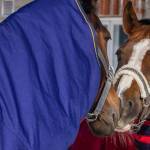Wintertime Cold and Flu Season: For Horses, Too?

According to the Centers for Disease Control and Prevention (CDC), the human flu season in the United States peaks between December and February, although the influenza virus circulates year-round. Why the influenza virus causes disease more commonly in these months remains a mystery, though several theories exist, including:
- People spend more time indoors with the windows sealed in the winter, so they are more likely to breathe the same air as someone who has the flu;
- Lack of sunlight in the winter leads to low vitamin D and melatonin levels, and therefore a compromised immune system; and
- The influenza virus may survive better in the colder, drier conditions experienced in the Northern Hemisphere in the winter.
Equine influenza viruses are highly contagious and can rapidly spread through populations. Unlike humans, no “flu season” has yet been identified in horses. Instead, the most important factors contributing to an increased risk of infection with equine influenza virus are:
- Age, as horses between 1 and 5 years old are typically affected, although horses of any age can succumb to disease;
- Horses with low circulating levels of specific antibodies, usually derived from vaccination, that fight off the influenza virus; and
- Frequent contact with large numbers of horses.
Unvaccinated horses have a higher risk of infection, particularly when commingling with other horses at competitions, sales, or other events. Experts theorize that even vaccinated horses can be “overwhelmed” when frequently exposed to the influenza virus or when the virus mutates and becomes unrecognizable to the immune system.
This latter situation is referred to as either antigenic drift or antigenic shift. Antigenic drift occurs when minute genetic changes lead to alterations in a virus’s surface proteins, which are called antigens. Because the changes are minuscule, antibodies created by the immune system to fight one virus will usually recognize and respond to similar viruses, unless the changes are cumulative and create an antigen arrangement that is significantly different than predecessors. When antigenic drift occurs over time, eventually the immune system may not recognize the virus, thus becoming susceptible to disease. Antigenic shift, on the other hand, is a sudden and significant change in a virus, resulting in new antigens, and the inability of the immune system to handle the virus effectively.
Veterinary researchers and immunologists modernize existing influenza vaccines to best match the current forms of the virus circulating in horse populations. One group of international researchers* recently created a vaccine that provides maximal protection against modern influenza strains. The techniques this team used also generated a vaccine “backbone” that allows the rapid production of future influenza vaccines to avoid vaccination/virus mismatch.
“In addition to vaccination and implementation of appropriate biosecurity measures, owners can help minimize infectious disease by boosting their horse’s immune system,” advised Catherine Whitehouse, M.S., an advisor for Kentucky Equine Research.
Scientific studies show that omega-3 fatty acids supplements such as EO-3 can enhance host immune responses when faced with a disease challenge.
“The practice of using nutrients like omega-3 fatty acids to support the immune system or other body processes is referred to as ‘immunonutrition’ and has been gaining momentum in the equine industry,” explained Whitehouse.
*Blanco-Lobo, P.L. Rodriguez, S. Reedy, et al. 2019. A bivalent live-attenuated vaccine for the prevention of equine influenza virus. Viruses 11:10.








